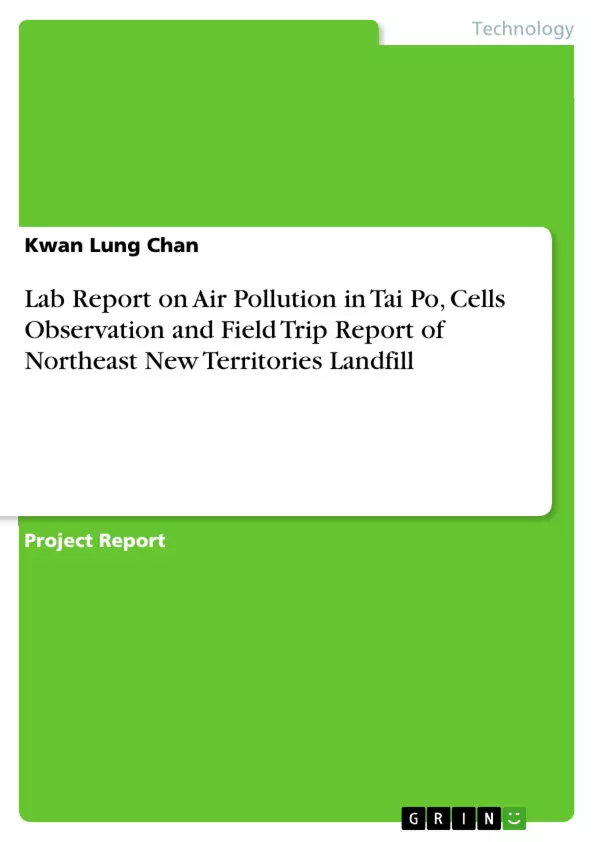This report aims to measure the air quality in term of level of PM2.5 in the Hong Kong Institute of Education and to observe animal and plant cells under light microscope.
Based on the field trip on 10th November, 2015, our observation on the solid waste treatment process in North East New Territories (NENT) landfill will be discussed, as well as the overall solid waste management strategy in Hong Kong.
Inhaltsverzeichnis (Table of Contents)
- Laboratory Report 1
- Laboratory Report 2
- Laboratory Report 3
- Field Trip Report of Northeast New Territories Landfill
Zielsetzung und Themenschwerpunkte (Objectives and Key Themes)
This report details the findings of experiments measuring PM2.5 levels in various locations within the Hong Kong Institute of Education. The objectives were to assess air quality, specifically focusing on PM2.5 concentration, and to investigate the influence of factors such as air conditioning and room size on these levels.
- Air quality assessment using PM2.5 as an indicator.
- Impact of air conditioning on indoor PM2.5 levels.
- Influence of room size on indoor PM2.5 levels.
- Comparison of PM2.5 levels in different indoor environments.
- Methodology and data analysis techniques in environmental science.
Zusammenfassung der Kapitel (Chapter Summaries)
Laboratory Report 1: This report details an experiment measuring PM2.5 levels in the Hong Kong Institute of Education. The experiment utilized both Minivol and DustTrak devices to measure PM2.5 concentrations in an air-conditioned laboratory, a non-air-conditioned classroom, and a non-air-conditioned lecture theatre. The rationale behind using different devices and locations was to investigate the impact of both air conditioning and room size on PM2.5 levels. The results showed significantly lower PM2.5 levels in the air-conditioned laboratory compared to the non-air-conditioned classroom, suggesting a strong correlation between air conditioning and reduced particulate matter concentration. The comparison between the classroom and the lecture theatre also revealed a significant difference in PM2.5 concentration, highlighting the effect of room size on air quality. The discussion analyzes these findings in relation to air convection and atmospheric inversion, proposing further investigation into the effects of measurement height within non-air-conditioned spaces.
Schlüsselwörter (Keywords)
PM2.5, air quality, air pollution, air conditioning, room size, indoor air quality, Hong Kong Institute of Education, Minivol, DustTrak, particulate matter, environmental science, experimental methodology, data analysis.
Frequently Asked Questions: Comprehensive Language Preview of Air Quality Experiments
What is the subject of this report?
This report details experiments measuring PM2.5 levels (fine particulate matter) in various locations within the Hong Kong Institute of Education. It focuses on assessing air quality and investigating the influence of factors like air conditioning and room size on PM2.5 concentrations.
What are the main objectives of the study?
The primary objectives are to assess air quality using PM2.5 as an indicator, to determine the impact of air conditioning on indoor PM2.5 levels, to investigate the influence of room size on indoor PM2.5 levels, to compare PM2.5 levels across different indoor environments, and to showcase methodology and data analysis techniques used in environmental science.
What experiments were conducted?
Laboratory experiments measured PM2.5 levels using Minivol and DustTrak devices in various locations including an air-conditioned laboratory, a non-air-conditioned classroom, and a non-air-conditioned lecture theatre. A field trip report on the Northeast New Territories Landfill is also included.
What were the key findings of Laboratory Report 1?
Laboratory Report 1 showed significantly lower PM2.5 levels in the air-conditioned laboratory compared to the non-air-conditioned classroom and lecture theatre, highlighting the impact of air conditioning. A difference in PM2.5 concentration between the classroom and lecture theatre also indicates the effect of room size. The results suggest a correlation between air conditioning, room size, and reduced particulate matter concentration.
What are the key themes explored in the report?
Key themes include air quality assessment, the impact of air conditioning and room size on indoor air quality, the comparison of PM2.5 levels in different environments, and the application of environmental science methodologies and data analysis techniques.
What are the key words associated with this report?
Keywords include PM2.5, air quality, air pollution, air conditioning, room size, indoor air quality, Hong Kong Institute of Education, Minivol, DustTrak, particulate matter, environmental science, experimental methodology, and data analysis.
What reports are included in this preview?
This preview includes summaries of Laboratory Report 1, Laboratory Report 2, Laboratory Report 3, and a Field Trip Report of Northeast New Territories Landfill. The preview provides a comprehensive overview of the contents of each report.
What methodologies were used?
The study utilized Minivol and DustTrak devices for PM2.5 measurement. The report details the experimental methodology and data analysis techniques employed in the environmental science study.
Where were the experiments conducted?
The laboratory experiments were conducted within the Hong Kong Institute of Education. A field trip was also conducted to the Northeast New Territories Landfill.
- Arbeit zitieren
- Bachelor of Education (Music) Kwan Lung Chan (Autor:in), 2015, Lab Report on Air Pollution in Tai Po, Cells Observation and Field Trip Report of Northeast New Territories Landfill, München, GRIN Verlag, https://www.hausarbeiten.de/document/448236


